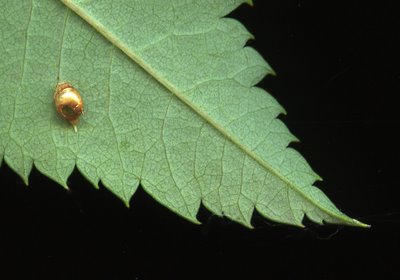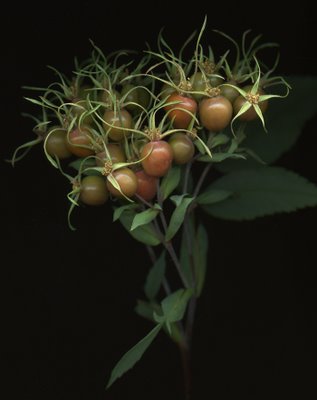Diplolepis rosae
Tuesday, August 05, 2008

As Rosemary and I worked in the garden we talked about the sadness of taking care of a garden after a couple of open gardens (the Ballet BC Home & Garden and the Vancouver Rose Society). If we had a large family the family would come and we would have garden parties. But we are lucky that Rebecca, Lauren and their mother Hilary do come on Saturdays. While the little girls are interested in the garden, Hilary sees it in much the same way I would a row of used office furniture. Rebecca brings the rose catalogue/manual I gave her and she is interested in my roses and in hers. There is some passion there. But when Rosemary and I are alone in the garden removing the collapsed plants of late summer there is little joy. We are already looking at plants that have to be moved or plants that we have to get rid of (a tough thing it is).
While pruning I noticed the interesting galls in one of our two Rosa glaucas. Of this rose I wrote here. I was telling Rosemary that in a garden with little room left there is no need to have two of them. One is in her perennial bed and the second one (a very large specimen) by the boulevard where it thrives in spite of the shade. It is this second specimen that has the galls. This time around I was determined to find out exactly what they were. The gall wasp or Diplodepsis rosae is the culprit. I have scanned one of the more interesting branches but I don't know if I am daring enough to cut them in half to see what is inside. Perhaps I can get Rebecca involved in this. She loves bugs. For more on the gall wasp read here. Or if lazy, the interesting stuff reads like this:
Gall wasps are in the family Cynipidae, order Hymenoptera, class Insecta, phylum Arthropoda.
Gall wasps are small (only a few millimetres long), dark-coloured insect with a compressed abdomen. Most gall wasps form galls, though a few live within the galls formed by other species; these are called inquilines. Others feed on gall-formers and inquilines.
The exact reactions which lead to gall formation in the host plant are little understood. Basically it is a reaction of the cells of the plant to the presence of the larva.
Rose galls are produced by Diplolepis rosae. These gall wasps usually reproduce asexually; the females are about 4 mm/0.2 in long; parts of their abdomens and legs are yellow-red, while the rest of the body is black. Males of this species have been observed only rarely. The galls are a mass of reddish filaments within which are found a number of sealed chambers enclosing larvae. The larvae feed on the gall tissue.
© Research Machines plc 2005
What I found interesting is that the gall is not always occupied by the gall wasp but by other wasps and or insects called inquilines. In Spanish the word inquilinos is what you call renters who do not own the house they live in.

The beauty of the rose wasp gall is further enhanced at this time of the year by the large racemes of rose hips. Rosa glauca's hips may not be as large as those in other roses but they are certainly plentiful. While the ones here remind me of small tomatoes, as they age the colour begins to resemble the colour of a Hershey bar. An added bonus when I scanned the gall was the little gold point on the bottom right leaf. You can see it if you look closely at the first image. It enlarges if you click on the image. I further scanned that tip to reveal some sort of sucking insect. As to why the gall wasp "rents" the boulevard Rosa glauca, and no other roses in my garden I have no inkling.







